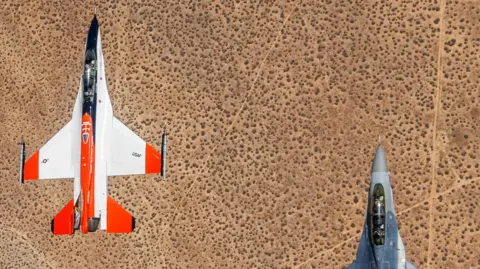 USAF
USAFI’m flying a Typhoon fighter over the Irish Sea and I’ve got a big problem.
There’s a hostile jet on my tail, and no matter how I push the joystick, or play with the throttle, this enemy is still there.
The threat is represented by a black triangle on the computer screen ahead of me that also displays a Typhoon cockpit. I’m in a series of three dogfights on a simulator and the results are not good.
That annoying little image won’t leave my six o’clock position, and I lose 3-0 to the ominous black triangle.
The ace I’m up against is an AI dogfighter developed by Turkish aerospace engineers commissioned by defence giant BAE Systems.
They’ve been working on an AI co-pilot that could save a real life aviator in a dogfight, and will find its way into sophisticated warfighting simulators.
One of the engineers, Emre Saldiran, is studying at Cranfield University in the UK, which has strong aerospace links. He describes how the AI co-pilot picked up fighting tactics by a process of trial and error. “We reinforce the AI’s learning with more and more data put into the dogfight simulator.”
One of his objectives is to address the information overload fighter pilots endure. His colleague Mevlϋt Uzun assures me that AI takes a lot of learning to beat humans. “The AI made millions of mistakes. Teaching it is like guiding a child.”
But once trained the AI can offer valuable advice, according to Mr Uzun.
“The AI can tell a pilot to slow down or speed up. And it can evaluate an emerging dogfight and warn of a 70% probability the pilot will lose if they get into that fight.”
So the AI warns pilots of situations likely to end in their jet being shot down and it takes that decision in milliseconds. But the design team aren’t making any big claims about it replacing a pilot.
“It’s just a piece of code, you could run it on your phone,” says Mr Uzun. Today their program is running off a normal laptop PC.
 Michael Dempsey
Michael DempseyThe US Air Force revealed its own, rather more elaborate, AI dogfighter in 2023. It was demonstrated flying an F-16 jet in combat manoeuvres.
This flight was the culmination of years of work aimed at creating an AI that could beat a living pilot.
Eight US AI companies went head to head in 2020 during a three-day competition known as the AlphaDogfight Trials Event. This involved simulated online dogfights between the competing AI programs and an experienced USAF fighter pilot.
The winning program beat the pilot repeatedly, and Brett Darcey of US defence shop Shield AI was on the three-strong team that built it.
He remembers the AlphaDogfight event vividly. “The competitors ranged from the big boys like [defence giant] Lockheed Martin down to us.”
They started out by pitching their AI pilot against a target flying straight and level, “a sitting duck” says Mr Darcey.
They progressed to fighting other AI pilots, getting the AI to think about tactics. Certain rules, such as the length of each dogfight (usually five minutes) and the maximum speed they could attain were set.
But there was no requirement to abide by USAF doctrine. “Our AI used a head-on merge with the target as an opportunity to fire guns,” he says.
This novel tactic went against accepted air fighting doctrine. The AI had learned to reject rules when it could spot a better move.
Points were awarded with each combat, the AI evolving to match successful outcomes. Multiple copies of the AI were generated by this evolution as the competing AI pilots measured up to each other’s changing tactics.
These heats left Mr Darcey’s group to oppose an experienced USAF fighter pilot wearing a VR headset that put him in the cockpit of an F-16.
Thanks to victories scored against that human pilot, Mr Darcey’s small team was invited into the government’s Defense Advanced Research Projects Agency (Darpa), which develops technology for the US Department of Defense.
Specifically, they joined Darpa’s Air Combat Evolution (ACE) project.
When Darpa’s AI-driven F-16 took to the air it was controlled during combat by a distant descendant of the software Mr Darcey’s team wrote in 2020.
AI evolves at a startling pace. Mr Darcey says this was “a many times removed grandson of the AlphaDogfighter AI.”
Despite a bewildering rate of development AI has a long way to go. The ACE jet has a safety pilot on board for take-off and landing who can switch off the AI at any time.
 USAF
USAFFor an AI pilot to be effective it has to win a lot of trust and be able to integrate into wider forces around it.
Intriguingly Mr Darcey says a big question is how an AI pilot can “explain itself on the ground”, debriefing human controllers on its actions and motives.
The UK AI dogfighter is very thrifty compared to its US cousin. “They are teaching the AI to fly an aircraft” says Dr Uzun. “We don’t need to do that.”
Paring the project down by concentrating on combat moves alone meant the Cranfield team worked fast. “What they took weeks to do we did in two days.”
One man whose career spans the rise of digital defence tools is Michael Hull. Now a principal technologist at BAE Systems in Warton, Lancashire, he joined the business as an apprentice electronics engineer in 1990.
Dramatic changes he has witnessed, include the way innovations that once emerged from inside defence companies now travel in the other direction. “We pull technology like AI into defence from the public domain.”
So, the AI dogfighter’s frugal heritage includes air-to-air combat tactics downloaded from Wikipedia, leaving classified information well out of the picture and contributing to the pace of the project.
 Mick Hull
Mick HullHow did the quick assembly British AI dogfighter fare against a real Top Gun?
Ben Westoby-Brooks flew Typhoons for the RAF and works for BAE Systems. He went up against the AI dogfighter and defeated it.
The AI dogfighter is no substitute for thousands of hours flying fast jets in very demanding circumstances. But it feeds into realistic online combat exercises and could reduce pilot overload in a genuine cockpit.

